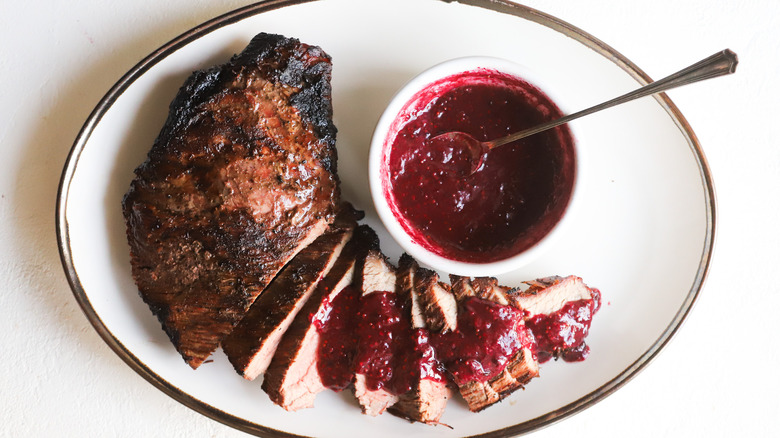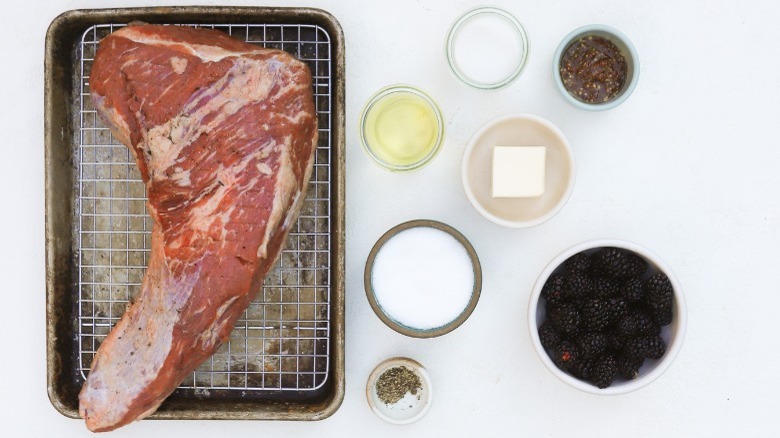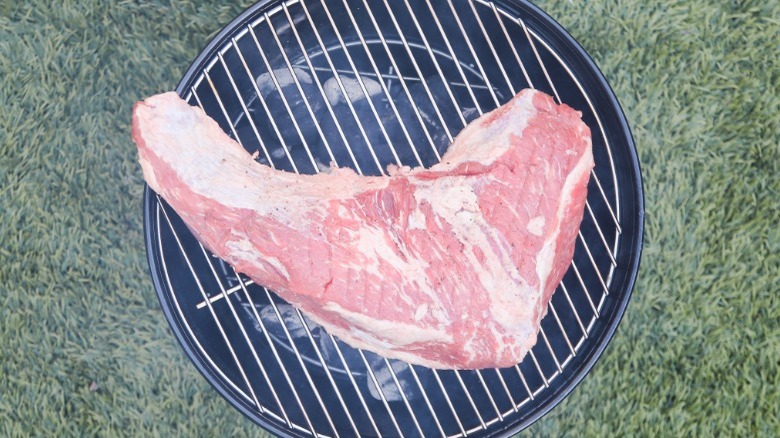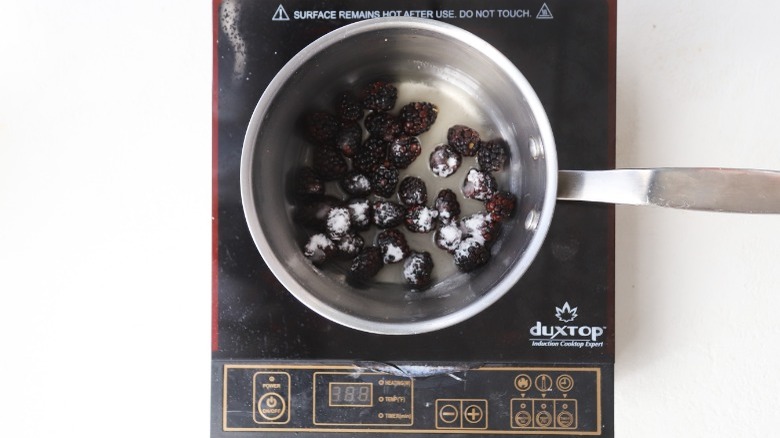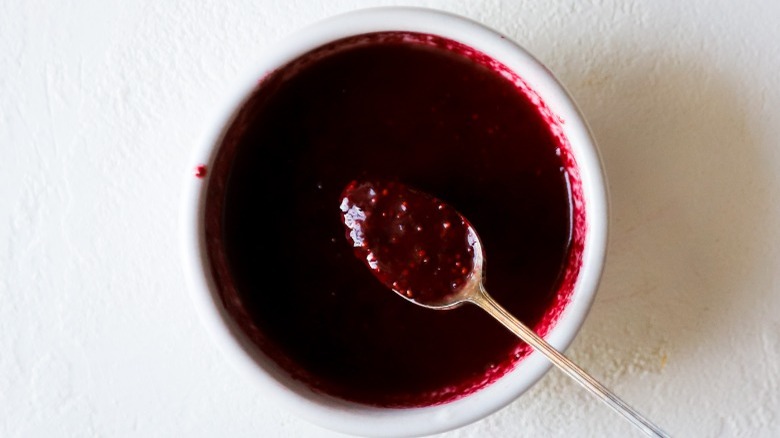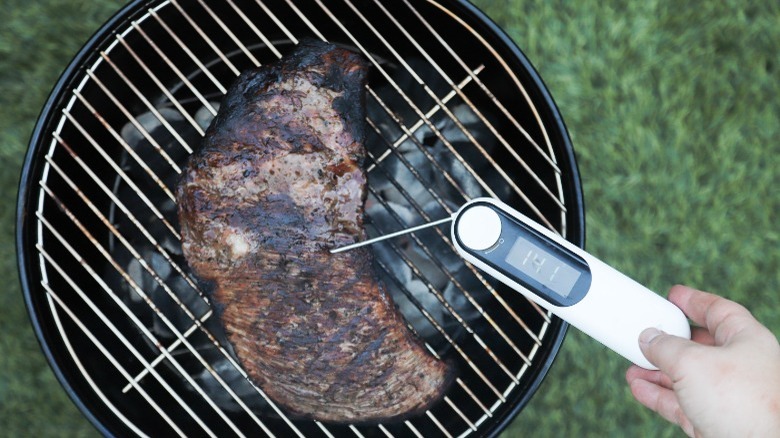Grilled Tri Tip With Blackberry Mustard Recipe
Tri-tip is a triangular cut of steak taken from the bottom of the sirloin. According to Steak School, tri-tip was traditionally used to make hamburger, but a clever butcher in California decided to market it as a specialty cut, and it proved to be a success. This makes it an affordable choice, and one of the best cuts to put on the grill. Because it comes from the sirloin, it's naturally lean but it can still caramelize exceptionally well. These qualities make it particularly good for barbecue, which is how it's most often cooked in Santa Maria, where the cut originated from.
"I'm from Southern California, so I grew up eating tri-tip regularly and had no idea for the longest time that it was a regional cut," recipe developer Taylor Murray told us. "It makes great sandwiches the next day sliced up and served cold, so I always grab one if there's a sale or I'm just feeling in the mood." In this recipe, tri-tip meets a tangy blackberry sauce for the perfect sweet-savory pairing you never knew you needed.
Gather the ingredients for grilled tri-tip with blackberry mustard sauce
Naturally, you'll need a tri-tip steak. This is usually a specialty cut and not always available. Speak to a butcher if you need help finding one. Ask for it trimmed to save yourself the headache of trying to do it yourself.
You'll season the steak with kosher salt and fresh-cracked pepper. For the sauce, you need some blackberries, sugar, white wine, whole-grain mustard and butter. "At a restaurant I once cooked at, we used pickled mustard seeds for a similar sauce. They mimic the texture of the blackberry seeds and offer an appealing, crunchy mouthfeel," says Murray.
Grill the beef
Get your gas or charcoal grill set up with a medium-high heat. Season your tri-tip with salt and pepper, then place it on the grill to sear — this should take about 6 or 7 minutes depending on your set up. Once the initial sear is done, you'll want to lower the heat or move the beef to a cooler spot. Keep cooking, flipping every few minutes, until the desired internal temperature is reached.
"The trick with tri-tip is that it's a larger roast and needs to be babied a bit on the grill," Murray explains. "Frequent turning will ensure even cooking."
Start the sauce
In a small pot, combine the berries, sugar, and wine. You will have an easier time with this sauce in a smaller pot, so opt for one with less than 2-quart capacity. Start the heat on high until the sugar is dissolved, then turn it to low. By the end, the berries should be burst apart. You can help them along by mashing with the back of a spoon.
If you want a richer sauce, you could swap the white wine for red. Keep in mind that blackberries are tart and so is red wine, so the sauce made with that type will be much punchier.
Strain and finish the sauce
Once your sauce has reduced to a thick syrup full of blackberry bits, remove from the heat and pass through a strainer to a small bowl. Push as much of the blackberry through the strainer as you can, then add a bit of the pulp back in. "This gives your sauce body and helps the butter to have something to hold on to," says Murray.
Return the sauce back to the pot over a low heat, add the mustard, then add cubes of butter one at a time, whisking constantly. If you've done it right, the resulting sauce should be a deep, creamy purple color. Do not make the mistake of swapping the cold butter out for melted butter. It won't emulsify into the sauce and will separate into a greasy pool on top.
Check the beef for doneness
By now, the beef should be approaching 135 to 140 F. Remove from grill once your desired internal temperature is reached, keeping in mind that it will continue to carryover cook a few degrees during resting. Let it rest on a cutting board for about ten minutes before slicing.
Carving a tri-tip can be tricky as the grain moves in two directions. Start from one end and when you get to the middle, adjust the beef so you are still slicing against the grain. When ready to serve, spoon some of the blackberry sauce over the top. This dish goes well with roasted potatoes or a nice, crisp salad. If you have leftovers, slice the beef thin for roast beef sandwiches.
Grilled Tri-Tip with Blackberry Mustard
Ideal for grilling, this tri-tip steak pairs well with a sweet, tangy blackberry mustard sauce.
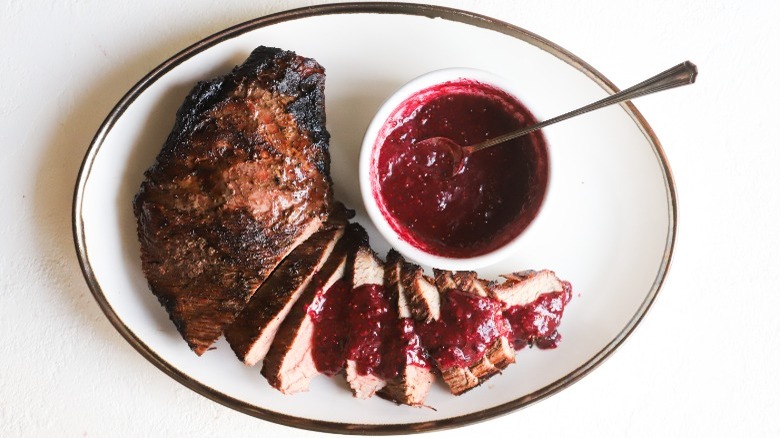
Ingredients
- 1 (3-pound) tri-tip steak, trimmed
- salt, to taste
- pepper, to taste
- 1 pint blackberries
- ¼ cup white wine
- 3 tablespoons granulated white sugar
- 3 tablespoons cold, unsalted butter
- 2 tablespoons whole grain mustard
Directions
- Prepare/preheat a charcoal grill or gas grill to high.
- Rub the tri-tip evenly with about 1 teaspoon each salt and pepper. Place the beef on the grill and sear until well browned, about 6 to 7 minutes.
- Lower gas grill to medium-low or move beef to cooler side of charcoal grill and continue to cook, flipping every few minutes, until the interior temperature reaches 130 F.
- Meanwhile, combine the blackberries, wine, and sugar in a small pot. Simmer until berries have softened and burst, about 10 minutes. Mash lightly with a spoon and continue to cook until liquid is thick and syrupy, about 10 more minutes.
- Pour mixture through a fine-meshed strainer and push solids through with a spatula. Return 1 tablespoon of blackberry puree to the strained liquid. Return to a simmer, then whisk in butter and mustard.
- Let the tri-tip rest on a cutting board for 10 to 15 minutes before carving. Serve with the blackberry mustard sauce.
Nutrition
| Calories per Serving | 744 |
| Total Fat | 41.0 g |
| Saturated Fat | 17.2 g |
| Trans Fat | 0.3 g |
| Cholesterol | 249.6 mg |
| Total Carbohydrates | 18.0 g |
| Dietary Fiber | 4.5 g |
| Total Sugars | 13.1 g |
| Sodium | 1,060.6 mg |
| Protein | 70.3 g |
